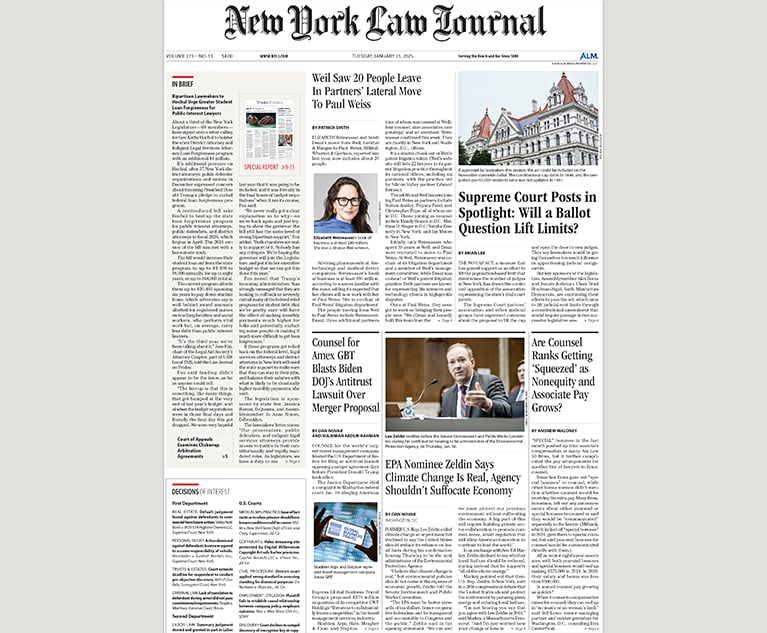Analysts Predict Slower Growth for Law Firms in 2019
New reports from Thomson Reuters and Citi Private Bank both found softening demand and growing expenses in the first quarter of 2019.
May 14, 2019 at 05:00 AM
4 minute read
The original version of this story was published on The American Lawyer
 Photo: Shutterstock
Photo: Shutterstock
After a high-flying 2018, two snapshots of the first quarter of 2019 should give law firms pause.
The Thomson Reuters' Peer Monitor Index found that demand and productivity had stalled in the first four months of 2019, while higher associate salaries contributed to surging expenses. But large firms both inside and outside of the Am Law 50 saw growth in another area: billing rates.
While the largest firms were the likeliest to benefit from significant rate hikes over 2017 and 2018, their smaller peers are now sharing in the bounty. According to Thomson Reuters, worked rates grew 3.8% over the last quarter, the strongest quarterly growth since 2012.
“The Am Law Second Hundred firms are now coming to that rate growth table,” said Thomson Reuters analyst Brent Turner.
While the Am Law 50 again led rate growth, with an increase of 5.5%, the Second Hundred raised rated a significant 4.1%, outpacing the AmLaw 51-100 (with growth of 3.9%) and midsize firms (3.3%).
A report released Monday by Citi Private Bank's law firm group also highlighted industry rate hikes, finding that lawyer billing rates grew 4.4% in the first quarter. But its breakdown differed: 5% growth for the top 50 firms, 4.1% for the second fifty, and 3% for the second hundred.
But both Citi and Thomson Reuters found that these rate increases were accompanied by softening demand. According to Thomson Reuters, demand dipped by 0.1%. Citi detected a drop of 0.3%—though revenues still grew faster than in the first quarter last year.
Turner drew a parallel to 2018, where demand slipped in the first quarter, before rebounding over the final three quarters of the year. That broke from the pattern of the previous years, where first quarter growth was followed by progressively decelerating demand.
He noted that litigation has been lagging, particularly in the midsize firm segment. Transactional work was mixed, with corporate work up 0.2%, while real estate dropped 0.8% and tax fell 2.1%.
The question for firms, according to Turner, is whether “2019 going to be like years before, or is it going to be like 2018.”
Expenses and Productivity
Diminished demand isn't the only worry. Both Thomson Reuters and Citi highlighted rising expenses in the first quarter.
One key piece of the puzzle was the impact of last year's associate salary increases.
Citi identified expense growth of 6.5%, driven by a 7.2% increase in lawyer compensation expenses. Thomson Reuters, meanwhile, said that direct expenses grew by 4.9%. Associate salaries account for 35% of that category, according to Turner.
Citi analyst David Altuna said that the salary increases suggested that firms were beginning to budge from the expense discipline they employed during the recession and post recession years.
“We do find that there's quite a push coming through from lawyer compensation,” he said. “We know that the associate compensation increases at midpoint last year are pushing that up higher, particularly for large firms.”
Turner, meanwhile, suggested that these increasing expenses exacerbated the challenge posed by growing head counts amid flat demand. The combination of the latter two factors led to a productivity decline of 1.8%, the worst dip since the third quarter of 2017.
While head counts grew at 1.6% in the first quarter of 2017, the increase dipped to 0.6% in the first quarter of 2018.
“We finally saw firms reigning in hiring practices, because of so many years of flat demand,” he said.
But head counts were up again in the last quarter, rebounding to 1.8%. That same rebound was not evident in the international markets that Thomson Reuters tracks.
“In other jurisdictions, we've seen them be much more disciplined,” Turner said. “U.S. firms were, at least from one quarter's worth of data, much quicker to get back to their historic hiring patterns.”
Read More
Law Firm Revenue Rose as Demand Dropped in the First Quarter of 2019
The Am Law 100 Reached New Heights, Driven by Nearly Universal Growth
Amid Segmented Market, Demand in 2018 Soars for Largest Firms, Report Says
This content has been archived. It is available through our partners, LexisNexis® and Bloomberg Law.
To view this content, please continue to their sites.
Not a Lexis Subscriber?
Subscribe Now
Not a Bloomberg Law Subscriber?
Subscribe Now
NOT FOR REPRINT
© 2025 ALM Global, LLC, All Rights Reserved. Request academic re-use from www.copyright.com. All other uses, submit a request to [email protected]. For more information visit Asset & Logo Licensing.
You Might Like
View All
Neighboring States Have Either Passed or Proposed Climate Superfund Laws—Is Pennsylvania Next?
7 minute read
Trending Stories
- 1Plaintiff Argues Jury's $22M Punitive Damages Finding Undermines J&J's Talc Trial Win
- 2Bannon's Fraud Trial Delayed One Week as New, 'More Aggressive,' Defense Attorneys Get Ready
- 3'AI-Generated' Case References? This African Law Firm Is Under Investigation
- 4John Deere Annual Meeting Offers Peek Into DEI Strife That Looms for Companies Nationwide
- 5Why Associates in This Growing Legal Market Are Leaving Their Firms
Who Got The Work
J. Brugh Lower of Gibbons has entered an appearance for industrial equipment supplier Devco Corporation in a pending trademark infringement lawsuit. The suit, accusing the defendant of selling knock-off Graco products, was filed Dec. 18 in New Jersey District Court by Rivkin Radler on behalf of Graco Inc. and Graco Minnesota. The case, assigned to U.S. District Judge Zahid N. Quraishi, is 3:24-cv-11294, Graco Inc. et al v. Devco Corporation.
Who Got The Work
Rebecca Maller-Stein and Kent A. Yalowitz of Arnold & Porter Kaye Scholer have entered their appearances for Hanaco Venture Capital and its executives, Lior Prosor and David Frankel, in a pending securities lawsuit. The action, filed on Dec. 24 in New York Southern District Court by Zell, Aron & Co. on behalf of Goldeneye Advisors, accuses the defendants of negligently and fraudulently managing the plaintiff's $1 million investment. The case, assigned to U.S. District Judge Vernon S. Broderick, is 1:24-cv-09918, Goldeneye Advisors, LLC v. Hanaco Venture Capital, Ltd. et al.
Who Got The Work
Attorneys from A&O Shearman has stepped in as defense counsel for Toronto-Dominion Bank and other defendants in a pending securities class action. The suit, filed Dec. 11 in New York Southern District Court by Bleichmar Fonti & Auld, accuses the defendants of concealing the bank's 'pervasive' deficiencies in regards to its compliance with the Bank Secrecy Act and the quality of its anti-money laundering controls. The case, assigned to U.S. District Judge Arun Subramanian, is 1:24-cv-09445, Gonzalez v. The Toronto-Dominion Bank et al.
Who Got The Work
Crown Castle International, a Pennsylvania company providing shared communications infrastructure, has turned to Luke D. Wolf of Gordon Rees Scully Mansukhani to fend off a pending breach-of-contract lawsuit. The court action, filed Nov. 25 in Michigan Eastern District Court by Hooper Hathaway PC on behalf of The Town Residences LLC, accuses Crown Castle of failing to transfer approximately $30,000 in utility payments from T-Mobile in breach of a roof-top lease and assignment agreement. The case, assigned to U.S. District Judge Susan K. Declercq, is 2:24-cv-13131, The Town Residences LLC v. T-Mobile US, Inc. et al.
Who Got The Work
Wilfred P. Coronato and Daniel M. Schwartz of McCarter & English have stepped in as defense counsel to Electrolux Home Products Inc. in a pending product liability lawsuit. The court action, filed Nov. 26 in New York Eastern District Court by Poulos Lopiccolo PC and Nagel Rice LLP on behalf of David Stern, alleges that the defendant's refrigerators’ drawers and shelving repeatedly break and fall apart within months after purchase. The case, assigned to U.S. District Judge Joan M. Azrack, is 2:24-cv-08204, Stern v. Electrolux Home Products, Inc.
Featured Firms
Law Offices of Gary Martin Hays & Associates, P.C.
(470) 294-1674
Law Offices of Mark E. Salomone
(857) 444-6468
Smith & Hassler
(713) 739-1250








